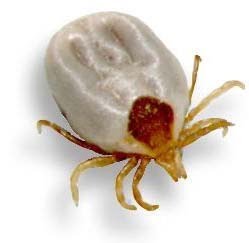A Turramurra Pet Care Article
Keeping your Pet Safe from Deadly Tick Paralysis

Keeping your Pet Safe from Deadly Tick Paralysis
by Dr Gretta Howard, Senior Veterinarian
What is a paralysis tick?
 The Australian paralysis tick, Ixodes holocyclus, is a small arthropod parasite unique to the eastern coast of Australia, extending from the Lakes Entrance in Victoria to tropical Queensland.
The Australian paralysis tick, Ixodes holocyclus, is a small arthropod parasite unique to the eastern coast of Australia, extending from the Lakes Entrance in Victoria to tropical Queensland.
Ticks attach to the skin of animals to consume blood for food. The natural host includes possums and bandicoots (immune to the tick toxin). In dogs and cats, the tick toxin is poisonous and can be fatal within 5 days of attachment.
Peak tick season extends from September to the end of February, although dogs and cats with tick toxicity are still seen during winter.
How does the paralysis tick make my pet sick?
Once attached, the tick injects a neurotoxin (nerve toxin) into your pet and causes signs of tick toxicity. Even with veterinary care, tick toxicity has a 5% mortality rate but the earlier your pet is treated the better the outcome.
Clinical signs of tick toxicity include:
- Vomiting or retching (mainly dogs)
- Change in the sound of your dog’s bark or your cat’s meow (vocal chord paralysis)
- Uncoordinated back legs or wobbly gait progressing to paralysis of all limbs
- Difficulty breathing progressing to respiratory failure and death
Signs of tick toxicity usually occur within 3 days of tick attachment.
One tick can kill a pet.
How can I prevent my pet from tick toxicity?
Preventing tick toxicity is preferred to treating tick toxicity, and in our local area, we strongly advise using a tick preventative all-year-round. Preventatives are available at Turramurra Veterinary Hospital for over-the-counter purchase.
Dogs
Our preferred product is a Bravecto chew given every 3 months with food.
There is also a topical Bravecto spot-on product which can be applied every 3 months (off-label use) instead of the chew, but in our experience, the chew is more reliable as a preventative product. The topical product is an option for dogs that refuse to eat the chew or cannot tolerate it.
Cats
Our preferred product is Bravecto spot-on applied every 2 months in cats that go outdoors or for cats that live with dogs (due to the potential for dogs to bring them indoors).
Seresto tick collar
For extra protection in both dogs and cats, use a Seresto tick collar to help repel ticks.
In conjunction with the Bravecto chew or spot-on, a Seresto collar can be worn, which acts as a repellent to ticks, but should not be relied upon by itself. A Seresto collar lasts 4 months and helps prevent tick bites and tick-borne parasites in your pet.
Search for ticks
As with all products, there is no guarantee, so we still recommend performing a daily tick search on your pet, particularly concentrating around the head, neck and shoulders, where 70% of ticks attach. A tick clip to keep your dog’s coat short in spring and summer can also help reduce tick paralysis because you can find the ticks more easily and remove them.
What should I do if my pet has a tick?
If you find a tick, your pet is still at risk of developing toxicity for up to 24 hours after tick removal, even if there are no clinical signs of tick toxicity at the time of tick removal. We recommend one of our vets remove the tick for you if you are unsure how to do this. A tick twister is a hook-like product which can assist in removing the whole tick quickly. Our vets can assess your dog properly to ensure there are no clinical signs of tick toxicity. Do not try to kill the tick before removing it from your dog or cat as this can increase the amount of toxin released.
How is tick toxicity treated?
If your pet is showing signs of tick toxicity and you are suspicious of a tick, then it is vital that you get to a vet urgently. Do not adopt a ‘wait and see’ approach as the earlier that treatment is started, the better the prognosis, because less neurotoxin will bind to your pet’s neuroreceptors.
Firstly, your pet will need to be hospitalised and given mild sedation to reduce anxiety and ease your pet’s breathing and then the anti-tick serum can be administered. This needs to be given slowly intravenously to reduce the risk of an allergic reaction. There is a higher chance of a reaction if your pet has previously received anti-tick serum.
It is important that pets with suspected tick toxicity have their coat clipped very short to ensure all ticks are removed as where there is one, there may be more ticks, and leaving a tick behind could be fatal. Clipping the hair coat can be a life-saver if a tick is located, so do not be too concerned about your pet’s hair – it will grow back.
The average length of hospital stay is 3-5 days, and depending on the severity of clinical signs, some pets will require intensive care such as urinary bladder expression, oxygen supplementation or even mechanical ventilation to treat respiratory failure at a 24-hour emergency hospital. Your vet will assess the severity of tick toxicity and advise you of the recommended treatment plan.
It is much better to prevent tick paralysis in the first place, than risk this deadly toxin affecting your pet.
What care does my pet need at home after tick toxicity treatment?
Food and water
Feeding or offering water to your pet too soon can cause pneumonia due to the affect the tick toxin has on the larynx, which means that sometimes food and water is inhaled. Do not feed your pet or offer water until recommended by your vet.
When giving water initially, offer 1cm in the bottom of the water bowl and remove if your pet is coughing or retching. A soft food only diet consisting of small portions only should be given for 7 days after discharge.
Never force feed your pet food or water and if you notice your pet having trouble swallowing, it is important to return for a veterinary reassessment.
Exercise
Tick toxicity can affect the heart so it is critical not to exercise your pet during the 4-week recovery period, even if your pet appears to have completely recovered. Unexpected sudden death does occasionally occur due to the effects of the toxin on the heart, so take care to ensure your pet rests and recuperates.
Toileting
Some pets have difficulty urinating as the tick toxin can affect bladder control. This can either cause incontinence or urine retention, where the bladder needs to be manually expressed by your vet. Ensure that your pet is producing a proper urine stream and once eating has resumed, monitor their defecation too.
Eye care
Sometimes pets lose their ‘blink reflex’, particularly if the tick has attached near an eye, causing local paralysis of the eyelid muscles. You can check your pet’s blink reflex by touching the corner of both eyes. Paralysed eyelids can lead to the eye drying out, risking an ulcer on the surface of the cornea. Lubricating eye ointment is often required until the eyes return to normal.
Veterinary assessment
Your vet may recommend a repeat consultation to assess your pet’s progress. This will include checking your pet’s gag reflex has returned to normal, assessing bladder size and your pet’s coordination.


